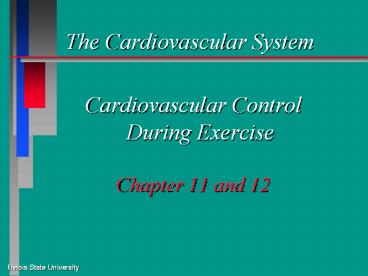The Cardiovascular System - PowerPoint PPT Presentation
1 / 27
Title:
The Cardiovascular System
Description:
The Cardiovascular System Cardiovascular Control During Exercise Chapter 11 and 12 Heart Structure and Blood Flow The atria receive blood into the heart; the ... – PowerPoint PPT presentation
Number of Views:481
Avg rating:3.0/5.0
Title: The Cardiovascular System
1
The Cardiovascular System
- Cardiovascular Control During Exercise
- Chapter 11 and 12
2
Heart Structure and Blood Flow
- The atria receive blood into the heart the
ventricles eject blood from the heart.
Atria
Ventricles
3
The Myocardium
- Because the left ventricle must produce more
power than other chambers, its myocardium is
thicker due to hypertrophy.
4
Cardiac Conduction
- Cardiac tissue is capable of autoconduction.
- It initiates its own pulse without neural control.
5
Cardiac Conduction
- The sinoatrial (SA) node is the hearts
pacemaker, establishing the pulse and
coordinating activity throughout the heart.
6
Extrinsic Control of Heart Activity
- Heart rate and contraction strength can be
altered by the autonomic nervous system or the
endocrine system.
7
Electrocardiography (ECG)
- The ECG is a recording of the hearts electrical
functioning. - An exercise ECG may reveal underlying cardiac
disorders.
r
p
t
q
s
8
Cardiac Function
- The cardiac cycle
- Relaxation diastole.
- Contraction systole.
- ECG waves P, QRS, T.
- Stroke volume.
9
Cardiac Function
- Ejection fraction from left ventricle (60 at
rest). - Cardiac output (4.8-6.4 L. min-1)
10
Vascular System
- Arteries.
- Arterioles.
- Capillaries.
- Venules.
- Veins.
11
Venous Return
- Blood returns to the heart through the veins,
assisted by - Breathing.
- Muscle pump.
- Valves.
- Valsalva Manuever
12
Distribution of Blood
- Activity dictates distribution.
- Vasoconstriction.
- Vasodilation.
13
Blood Pressure (NHLBI, 2003)
Pressure Normal Pre-hypertension Stage I Hypertension Stage II Hypertension
Systolic lt 120 120-139 140-159 gt 160
Diastolic lt 80 80-89 90-99 gt 100
Treatment
Otherwise healthy None None Diuretics for most, possibly other drugs Two-drug combo usually one is a diuretic
With other diseases None Medically treat diseases Multiple medications Multiple medications
14
Blood
- Blood and lymph are the substances that transport
materials to and from body tissues. - Fluid from plasma enters tissues, becoming
interstitial fluid.
15
Blood
- Most interstitial fluid returns to the
capillaries, but some enters the lymphatic system
as lymph, eventually returning to the blood.
16
Blood
- Blood is about 55 to 60 plasma and 40-45
formed elements including RBCs, WBCs, etc. - Hematocrit ration of blood cells to total blood
volume.
17
Blood
- Oxygen is primarily transported bound to the
hemoglobin in red blood cells. - As blood viscosity increases, so does resistance
to flow.
18
Total Peripheral Resistance
- TPR length x viscosity
- ______________
- (Radius)4
19
Response to Exercise
- As exercise intensity increases, HR increases.
20
Exercise
- The heart ejects blood more often, thus speeding
up circulation.
21
Response to Exercise
- Stroke volume also increases, so the amount of
blood ejected with each contraction increases. - Increases in HR and SV increase cardiac output.
22
Response to Exercise
- More blood is forced out of the heart during
exercise then when at rest, and circulation
speeds up.
23
Response to Exercise
- This insures that adequate supplies of the
needed materials - oxygen and nutrients - reach
the tissues and that waste products, which build
up much more rapidly during exercise, are quickly
cleared away.
24
Major Changes in Blood During Exercise
- The a-vO2 difference increases.
- Increased extraction of oxygen from the blood
for use by the active muscles.
25
Major Changes in Blood During Exercise
- Plasma volume decreases during exercise.
- Water is forced into tissues by increased blood
pressure. - Water also evaporates.
26
Major Changes in Blood During Exercise
- Hemoconcentration occurs as plasma fluid (water)
is lost. - Although the actual number of red blood cells
might not increase, the relative number of red
blood cells per unit of blood increases, which
increases O2 carrying capacity.
27
Major Changes in Blood During Exercise
- pH levels drops from resting values of 7.4 to
7.0 or lower. - Muscle pH decreases even further.
- The decrease in pH results primarily from
increased blood lactate accumulation with
increasing exercise intensity.































